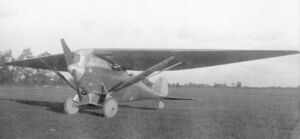Engineering:Dobi-II
From HandWiki
| Dobi-II | |
|---|---|

| |
| Role | Reconnaissance aircraft |
| National origin | Lithuania |
| Manufacturer | Dobi |
| Designer | Jurgis Dobkevičius |
| First flight | October 1923 |
The Dobi-II is the second airplane designed by Lithuanian aviator Jurgis Dobkevičius in 1922. It was tested in October 1923. After two landing accidents plans for mass production of Dobi-II were abandoned.[1]
The Dobi-II had long ailerons and were able to be folded due to an internal mechanism. This was most likely done to reduce storage, as the Dobi-II was intended for military usage. During the 1923's the Dobi-II was one of the fastest planes among the two seat aircraft with 200 hp engines. Additionally the hanging control column was used in the Dobi-II. [2]
Specifications
Data from Lithuanian Air Museum[1]
General characteristics
- Crew: 2
- Length: 6.1 m (20 ft 0 in)
- Wingspan: 14 m (45 ft 11 in)
- Wing area: 22.44 m2 (241.5 sq ft)
- Empty weight: 840 kg (1,852 lb)
- Gross weight: 1,240 kg (2,734 lb)
- Powerplant: 1 × Benz Bz.IV 6-cylinder water-cooled inline piston engine, 150 kW (200 hp)
Performance
- Maximum speed: 248 km/h (154 mph, 134 kn)
- Cruise speed: 190 km/h (120 mph, 100 kn)
- Stall speed: 90 km/h (56 mph, 49 kn)
- Range: 1,000 km (620 mi, 540 nmi)
- Service ceiling: 9,000 m (30,000 ft)
- Time to altitude: 34 min to 7,000 m (23,000 ft)
- Landing speed: 85 km/h (53 mph; 46 kn)[3]
References
- ↑ 1.0 1.1 "Dobi-II". Archived from the original on 3 September 2004. https://web.archive.org/web/20040903063201/http://www.lam.lt/istorija/karo_aviacija/dobkevic/d2/nfrd2en.htm. Retrieved 27 January 2017.
- ↑ "DOBI-II , 1/72 , Scratch built" (in en-GB). https://www.britmodeller.com/forums/index.php?/topic/235092999-dobi-ii-172-scratch-built/.
- ↑ Serryer, J (13 March 1924). "Les avions Dobkevicius". Les Ailes (143): 2–3. http://gallica.bnf.fr/ark:/12148/bpt6k6556089d/f2.
See also
 |

